Volleyball Lesson

Download the ultimate lesson in PDF
Download the lesson in PDF
- Learning Outcomes
- Differentiation: EAL/SEN Success Criteria
- 6 Dynamic Stations & Games
- Practical Teaching Tips
Learning Outcomes
LO1: Understand the fundamentals of volleyball, including the purpose of the game and the three basic contact techniques (underarm pass, overhead set, fingers pass)
Key Skills: Managing Information and Thinking, Being Creative
LO2: Perform each contact technique with correct form and consistency during technical drills (Volleytenis, Technique Station, Reception Station)
Key Skills: Managing Myself, Staying Well
LO3: Demonstrate effective footwork, court movement, and spatial awareness in the reception drill, moving to and striking from each cone station
Key Skills: Staying Well, Managing Myself
LO4: Apply learned techniques in small-sided competitive scenarios (2 vs 2 Volleytenis, 1 vs 1 Volleyfrontenis, 2 vs 2 scrimmages), communicating and self-officiating to maintain game flow
Key Skills: Working with Others, Communicating
LO5: Take on leadership roles by assisting with station setup and peer coaching in the circuit, organizing equipment and explaining exercises to classmates
Key Skills: Communicating, Working with Others
LO6: Exhibit sportsmanship and sustained motivation through rotation-based mini-games, maintaining a positive attitude and respecting teammates and opponents
Key Skills: Staying Well, Being Creative
Curriculum 🇮🇪
Junior Cycle Physical Education
Strand: Games
Key Skills: Staying Well; Managing Information and Thinking; Managing Myself; Working with Others; Communicating; Being Creative
Target Group
Junior Cycle students (ages 12–15)
Duration
1 hour
Success Criteria / Quick Assessment
Technique Accuracy: Students perform the three contact skills (underarm pass, overhead set, fingers pass) with correct body position and hand placement in at least 80% of repetitions during drills.
Rally Maintenance: In small-sided games, pairs or trios sustain rallies of five or more consecutive contacts at least twice within a timed rotation.
Self-Officiating & Sportsmanship: Learners call their own faults/travels correctly and demonstrate respectful communication—no more than one teacher intervention per game to correct a call.
Differentiation Strategies
Mixed-Ability Groups: Create two parallel circuits:
Support Circuit: Use a balloon or beach ball and half-court; focus on basic underarm passes and controlled sets.
Challenge Circuit: Use a regulation volleyball and full-court width; require alternating forearm and overhead sets in continuous three-contact rotations.
Warm up
- Duration: 10 min
Cardio + Mobility
Gather students in a circle.
Count aloud from 1 to 5 (one count per second). When everyone reaches 5, switch to the next exercise (if the group is very large, count only to 2 or 3).
Game: Touch the back of a partner’s knees without letting them touch yours.

Circuit
- Duration: 20 min
Station 1: Volley Tennis
- Duration: 5 min
Setup: Define a small court, waist-high net.
Rules: Only forearm pass allowed. Ball may bounce once; only one contact before sending it over.
Format: 2 vs 2 or 1 vs 1 matches to 3 poin
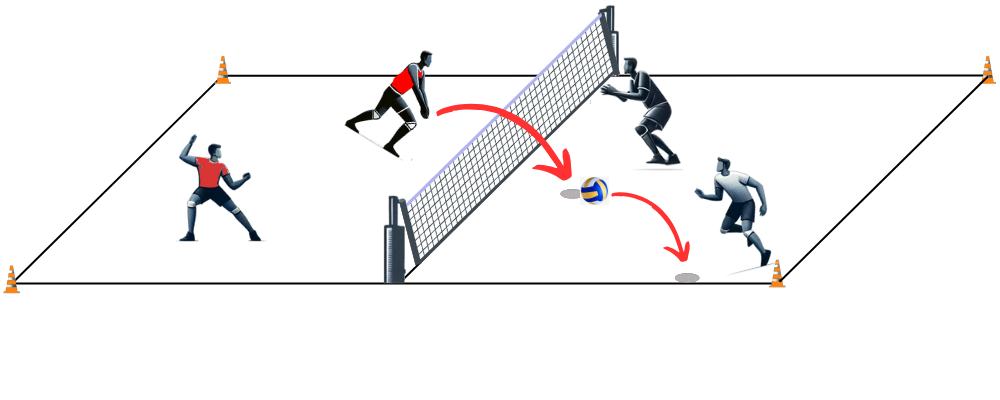
Station 2 – Technique
- Duration: 5 min
Levels: 3 progressive levels. At each, students start lying or seated, then stand up and sit down while executing contacts.
Level 1 – Finger pass (set)
Level 2 – Forearm pass (bump)
Level 3 – Alternate finger and forearm passes
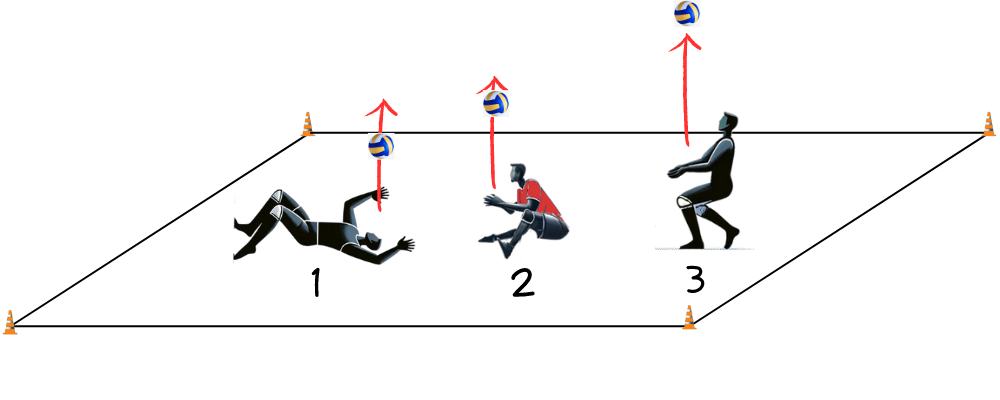
Station 3 – Receptions
- Duration: 5 min
Setup: Line up 4 cones in a straight line away from the net. Students work in pairs: one throws, the other receives.
Action: Receiver moves to the first cone, then performs a forearm reception back to the thrower, then proceeds to the next cone, and so on through all four.
Levels:
Level 1 – Simply move to each cone before receiving
Level 2 – Must touch each cone before receiving
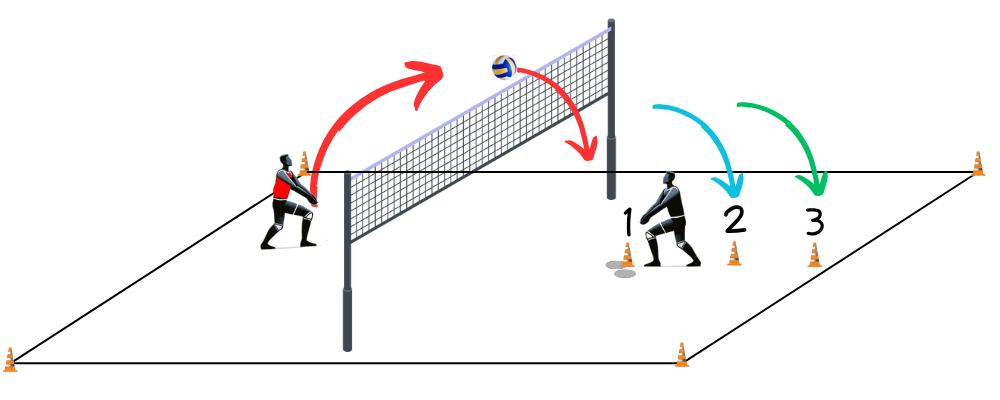
Station 4 – Volley Front Tennis
- Duration: 5 min
Setup: Small court facing a wall marked at waist height.
Rules: Only finger pass allowed. Ball may bounce once; only one contact before wall-strike.
Format: 1 vs 1 matches to 5 points.

Game Situation
- Duration: 5 min
Setup: Use the longest net available and create multiple 2 vs 2 courts along its length.
Action: Play 2-minute matches. At the end of each match, rotate opponents so every pair plays multiple rounds.
Grouping: Pairs
Variaciones
Juego Zona Frontal
- Duration: 5 min
Setup
Mark a rectangle from the net back to the attack line (3 m from the net) across the full court width.
Teams of 2 players each on either side of the net.
Action
Rally play over the net, scoring on unreturned balls or errors (first to 3 points wins each rally).
Maximum of 3 team contacts; ball must land inside the front-zone rectangle after crossing the net.
Levels
Level 1: Forearm only (bump pass)
Level 2: Fingers only (setting technique)
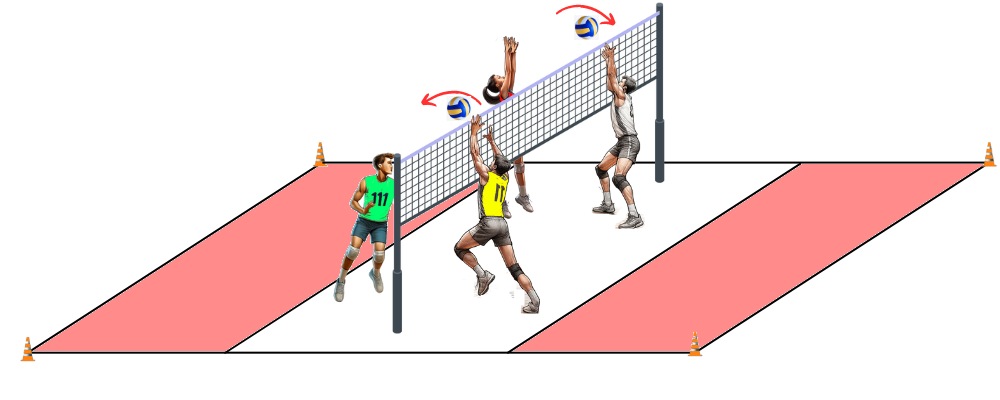
Juego Zona Trasera
- Duration: 5 min
Mark a rectangle from the attack line back to the end line (baseline), full court width.
Teams of 2 players each in the back-zone rectangle.
Action
Rally play over the net; only contacts made from inside the back-zone rectangle count.
First to 3 points wins each mini-game; up to 3 team contacts per rally.
Levels
Level 1: Fingers only (setting technique)
Level 2: Forearm only (bump pass)
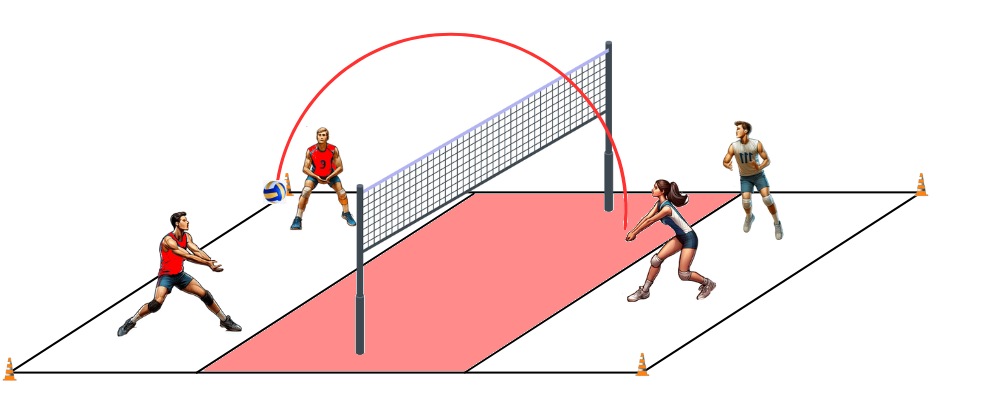
Clarifications & Tips
- Duration: 5 min
You can adapt this volleyball lesson as you wish. Circuits are a highly effective way to work technique, tactical aspects, and game-like situations in one class, keeping it dynamic. Over several sessions, this format builds a solid foundation before moving on to more complex activities—your students will thank you and bring energy to every class!

Download the ultimate lesson in PDF
Download the lesson in PDF
- Learning Outcomes
- Differentiation: EAL/SEN Success Criteria
- 6 Dynamic Stations & Games
- Practical Teaching Tips
Attention: To keep delivering high-quality, innovative resources, we need your support. Purchase our exclusive PDF for a complete PE lesson you can implement immediately. Invest in your professional development and help sustain our website!
© 2025 ThePhysicalEducationLab. All Rights Reserved.
